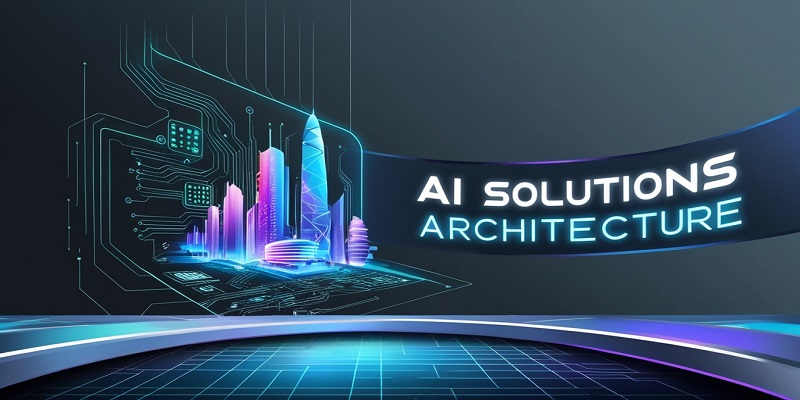AI Solutions Architecture: Designing Robust AI Systems

Artificial intelligence (AI) has become a pivotal force, influencing industries, businesses, and personal lives. However, building AI systems that are both powerful and resilient requires a well-thought-out architectural approach. AI solutions architecture is the design process behind developing such systems, ensuring they are not only effective but also robust, scalable, and maintainable.
AI solutions architecture refers to the structured approach used to build AI systems. It involves integrating various components such as algorithms, data pipelines, hardware infrastructure, and software systems. This architecture ensures that AI solutions can process data, learn from it, and generate insights or predictions efficiently.
While the concept may sound straightforward, the reality of designing an AI system is complex. It requires consideration of multiple factors, such as the volume of data, the need for real-time processing, scalability, and security. Furthermore, AI systems must be adaptable to different environments, making the design process a critical component of the solution’s long-term success.
Key Components of AI Solutions Architecture
When designing AI solutions, there are several key components that need to be considered. These elements help in building systems that can handle large data volumes, perform accurate computations, and scale effectively.
Data Pipelines
Data is the fuel for AI systems. A well-constructed data pipeline ensures that data flows smoothly from raw sources to the AI model. This involves processes like data collection, cleaning, transformation, and storage. For example, in a machine learning model, raw data may need to be normalized or encoded before being used for training. A robust data pipeline ensures that the model receives the right kind of data, reducing the likelihood of errors and improving model accuracy.
Modeling Frameworks
AI solutions require the right framework to support the training and deployment of models. Popular frameworks include TensorFlow, PyTorch, and Scikit-learn. The choice of framework depends on the complexity of the task, the team’s familiarity with the tool, and the specific AI model being implemented.
The architecture also includes determining where models will run—in the cloud, on local machines, or on edge devices. For instance, cloud-based frameworks offer scalability, while edge computing frameworks allow AI solutions to run closer to the source of data, providing faster real-time insights.
Compute Infrastructure
AI models require significant computing power, particularly during the training phase. The right hardware infrastructure is essential to ensure the system can handle large-scale computations. In some cases, this might involve using Graphics Processing Units (GPUs) or specialized hardware like Tensor Processing Units (TPUs). A well-architected solution also considers the trade-off between cloud-based versus on-premises infrastructure. For many organizations, cloud infrastructure offers greater flexibility and scalability, while on-premises solutions provide more control and security.
Automation and Orchestration Tools
Once an AI model is developed, it needs to be deployed in a way that ensures its performance is continuously monitored. Automation and orchestration tools like Kubernetes, Docker, or Airflow help in managing this process. They enable AI systems to be deployed at scale, track performance, and trigger retraining when necessary. These tools also assist in scaling AI systems, ensuring that they can handle increasing workloads without significant downtime.
Designing for Scalability and Flexibility
A critical consideration in AI solutions architecture is scalability. As data volumes grow, AI systems need to be able to scale without requiring a complete redesign. Scalability can be achieved through various techniques, including horizontal scaling (adding more machines) and vertical scaling (increasing the power of existing machines). Additionally, systems should be designed with modularity in mind. This ensures that different components can be swapped out or upgraded as needed, without disrupting the entire system.
Another important aspect is flexibility. AI systems should be able to adapt to new data sources, changing business requirements, or updated algorithms. For instance, as new AI techniques such as reinforcement learning or transfer learning emerge, the architecture should allow for easy integration of these approaches.
Challenges in Designing AI Solutions
Designing robust AI systems comes with its share of challenges. Some of the most common hurdles include:
Data Quality and Availability
One of the most significant challenges in AI solutions architecture is ensuring high-quality data. AI systems are only as good as the data they are trained on. Poor data quality—whether due to missing values, inaccuracies, or biases—can significantly affect model performance. Moreover, AI systems often require large amounts of data, which may not always be readily available.
Complexity in Model Training
Training AI models, especially deep learning models, can be incredibly resource-intensive. It often requires a significant amount of computational power and time. Additionally, the process can be complex, involving hyperparameter tuning, model evaluation, and frequent iterations. These complexities need to be accounted for in the architecture, with appropriate hardware and software configurations.
Ethical and Security Concerns
AI systems are vulnerable to ethical and security issues, such as data privacy concerns, bias in decision-making, and the potential for misuse. Architects need to integrate security measures and ethical considerations into the design process. For example, encryption and secure data handling protocols must be in place to protect sensitive information. Similarly, fairness and bias checks should be incorporated to ensure the AI model doesn’t perpetuate harmful stereotypes.
Integration with Legacy Systems
Many organizations have existing legacy systems that may not be compatible with modern AI solutions. Integrating these older systems with new AI technologies can be a significant challenge. Architects must develop solutions that bridge this gap, ensuring seamless data flow and system compatibility.
Best Practices for AI Solutions Architecture
To design robust AI systems, several best practices can guide the architectural process. These practices help in overcoming challenges and ensuring that the solution is not only efficient but also scalable and adaptable.
Start with a Clear Problem Definition
Before jumping into AI system design, it’s essential to have a clear understanding of the problem you’re trying to solve. AI systems are highly specialized, and their architecture should align with the specific use case. For example, a recommendation system for an e-commerce platform will have vastly different requirements than an AI-driven medical diagnosis tool. Defining the problem early on ensures that the right tools, frameworks, and methodologies are selected.
Prioritize Data Governance
Effective data governance is critical to the success of any AI system. This involves not only ensuring data quality but also managing data security, privacy, and compliance. In many industries, AI solutions must adhere to strict regulatory standards, such as GDPR in Europe or HIPAA in healthcare. The architecture should be designed to enforce these regulations, incorporating data encryption, access controls, and audit logs.
Embrace Continuous Learning
AI models should not be static. The architecture should allow for continuous learning, meaning that the model can be updated and retrained as new data becomes available. This ensures that the AI system remains accurate and relevant over time. For instance, an AI system designed to detect fraud in financial transactions must continuously learn from new fraud patterns to remain effective.
Monitor Performance and Optimize
Once deployed, the AI system’s performance should be continuously monitored. Tools like Prometheus, Grafana, or custom dashboards can help in tracking key metrics such as accuracy, latency, and resource usage. Regular optimization of both hardware and software components ensures that the system remains efficient and cost-effective.
Conclusion
Designing robust AI systems is a complex but rewarding process that requires careful consideration of various architectural components. From data pipelines and modeling frameworks to compute infrastructure and automation tools, each aspect plays a critical role in the system’s overall success. By adhering to best practices and addressing common challenges, architects can build AI solutions that are not only powerful but also scalable, flexible, and secure.





